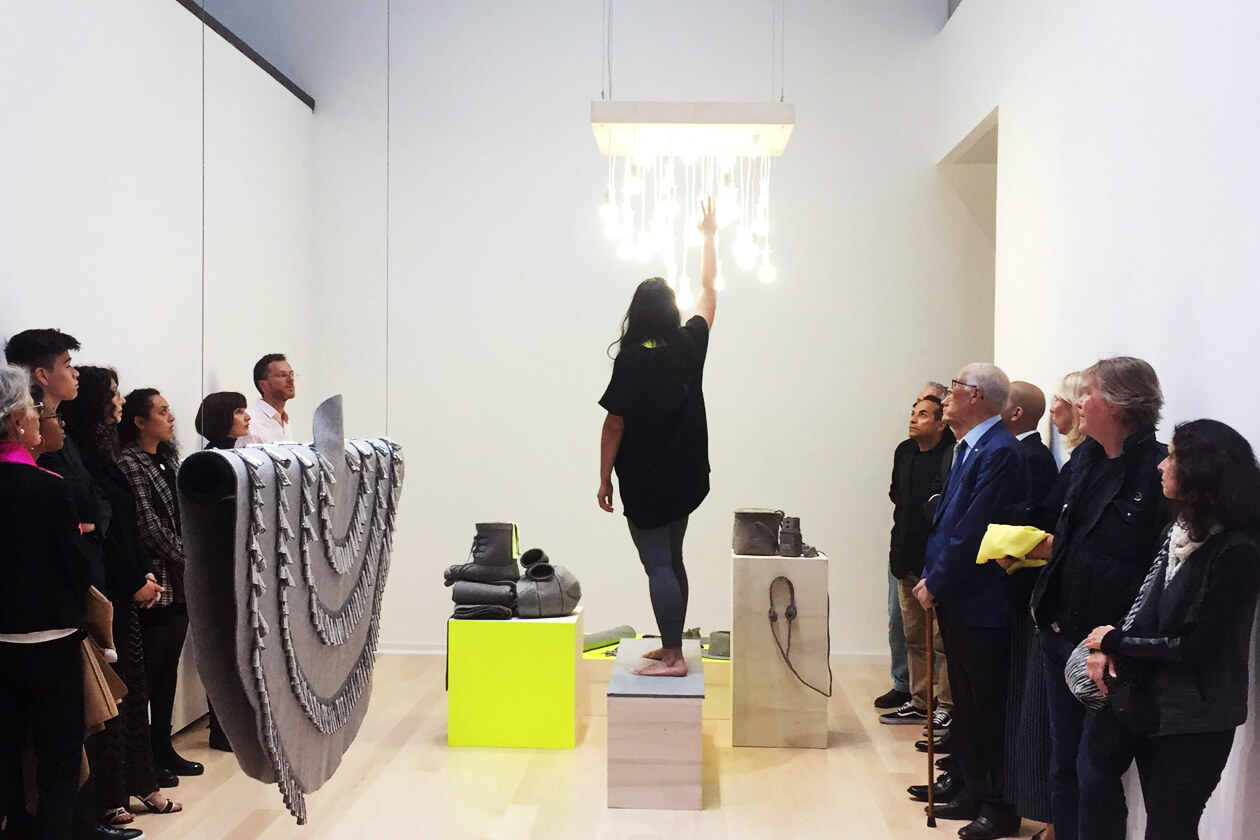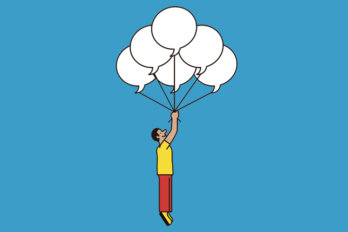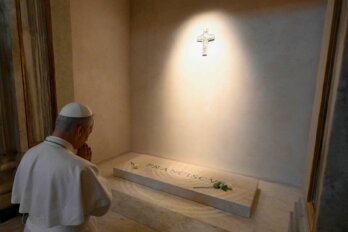On a crisp September Tuesday evening in Paris, Maria Hupfield, a Wasauksing First Nation performing artist from Brooklyn, New York by way of Parry Sound, Ontario, is making her place in the atrium of the Canadian Cultural Centre. Or, at least, that’s one way of interpreting what she’s up to at the international opening of her first major travelling solo exhibition.
Hupfield is hard to read. She makes works like Snowmobile Suit for the Hudson (2013), a Ski–Doo outfit complete with Sorel boots, mitts, and a helmet that are fashioned from grey industrial felt. Then she performs with them, adding meaning and experience (and value to collectors) beyond the object’s materiality. For her globe–trotting performances, the forty–three–year–old York University–trained artist has wandered through the deciduous grasses of Santa Fe’s brittle arroyos and assembled a full–size, felt Anishinaabe hunting canoe while in Venice, Italy. Resisting the Western tendency to essentialize Indigenous art, Hupfield’s practice is dynamic and multidimensional. Her work refuses to be captured by categorization.
Hupfield herself is inviting if a little awkward. Her artistic process relies on hand stitching, which is rarely, if ever, endowed with the rock–star glamour of more historically masculine techniques, like painting and sculpting. Rising artists with their sights on fame can be difficult to approach, but not Hupfield. When I first meet her before her show in Paris, she’s chatting and posing for selfies with family, friends, and fans. Tonight, as at many of her performances, she wears an unassuming ensemble—grey leggings, an oversized black tunic, and a yellow undershirt—that makes her look like a yoga mom, and she is, among other things, a mother, which is a familial relationship central to this exhibition.
The centrepiece of Hupfield’s show is an oil painting of Georgian Bay, waves rolling and horizon bobbing, rendered by her late mother, whose Anishinaabe name, translated into English, also serves as the show’s title: The One Who Keeps on Giving. Hupfield’s is just the second exhibition ever in the recently combined Canadian embassy and cultural centre.
This is a constrained setting for art, and not only because visitors have to walk through a metal detector to enter a sleek gallery ensconced within a bureaucracy. The embassy is a launching pad for Canadian political and economic power, a place for diplomats to meet and common folk to apply for passports, visas, and citizenship. The cultural centre, the embassy’s hip housemate, is stage for a more ephemeral form: the arts. Under the same roof, the two make for an awkward pair, and I get the sense that the cultural centre could use a little distance from its more buttoned–up roomie. But, in Paris, the citadel of art history, a metropolis that nearly doubles as museum, this diplomatic union is important to Canada’s mission abroad. “If you want to be taken seriously as a player in Paris, as a country in Paris, you have to explain to your local audience what you’re about,” says Graeme C. Clark, Canada’s deputy head of mission in France, over cocktails. “And that means the arts, that means culture, that means film, that means all the forms of artistic creation.”
In the first two exhibitions at the recently wedded embassy and cultural centre, both by First Nations artists, Canada has presented the story of its Indigenous origins, its fraught colonial past, and its reconciling present. Kent Monkman, a Cree painter known for his subversive and epic landscape portraits, inaugurated the space with Beauty and the Beasts, a meditation on cultural appropriation and dispossession. His show closed three weeks before Hupfield’s opened. Elsewhere in the Canadian diplomatic system, other Indigenous artists have occupied similar spaces. Lawrence Paul Yuxweluptun, a Coast Salish and Okanagan painter whose northwest–coast style works depict an Indigenous counternarrative not unlike Monkman’s, recently showed at Canada House in London’s Trafalgar Square. These exhibitions are one sign among many of an Indigenous renaissance sweeping Canada and the globe.
But they are also the product of a simple curatorial calculation: Indigenous arts and culture are the most unique and authentic thing Canada has to offer the world. In the 1970s, as Prime Minister Pierre Trudeau sought to strengthen relations with the Soviet Union and China, key ministers like Jean Chrétien facilitated exhibitions of Inuit art behind the Iron Curtain in Moscow, Leningrad (now Saint Petersburg), Shanghai, and Peking (now Beijing). And, in 1991, Haida sculptor Bill Reid completed and installed The Spirit of Haida Gwaii at the Canadian embassy in Washington, DC. The piece was also featured on $20 notes issued between 2004 and 2012. “It’s part of our brand,” Clark says of Indigenous art. “I don’t mean that in any sort of commercial sense. I just mean that it’s part of who we are. It’s a part of getting an audience in France to understand that’s what Canada’s about.”
With racial resentment on the rise, especially here in France, where Marine Le Pen’s far–right National Rally has gained ground in recent years, liberal multicultural Canada has an agenda. In November 2017, the Standing Senate Committee on Foreign Affairs and International Trade discussed the importance of cultural diplomacy to Canadian power. “In an age that seems increasingly characterized by radicalization, by the resurgence of right–wing nationalisms, by the urge to close borders, and by the reintroduction of protectionist measures, Canada is seen on the global stage as a voice for moderation and tolerance.” Sarah Smith, a professor at Carleton University, told that committee. “It is ‘Canada’s moment,’ so let’s take advantage of it.”

But, in Canada’s moment, art and agenda have a tense relationship—especially for Indigenous artists navigating the cross–currents of a multicultural message abroad and settler–colonial reality back home. From pipelines forced through Indigenous territories to unsolved cases of missing and murdered Indigenous women to forty–some long–term boil water advisories in First Nations communities to wildly disproportionate confiscation of Indigenous children by child services and similarly outsized incarceration and brutalization of Indigenous people through the criminal–justice system, Indigenous artists have a bone—or two, or ten (but who’s counting)—to pick with the Canadian nation–state superimposed across their lands.
In similar circumstances, artists of earlier generations, like Reid, revitalized traditions that had been pushed to the brink, and contemporary painters like Monkman and Yuxweluptun have held fast to their anticolonial guns. Hupfield’s approach is different. Unlike her counterparts painting irreverent contra–histories, Hupfield does not construct a narrative in the first place. She’s after something more elemental. Consider her 2016 piece It Is Never Just About Sustenance or Pleasure, a ten–minute video in which Hupfield meanders through a riverbed outside Santa Fe in grey felt river boots and snowmobile mittens, interacting with art and landscape: breaking twigs underfoot, tapping cattails with gloved fingers, and doing other serious, strange, and humorous things before removing boots and mittens to reveal hands clothed in beautiful satin gloves, made in part from the neon ribbon a Native dancer might use to craft powwow regalia. The video suggests many themes, like place, ecology, migration, identity, and climate change, but cannot be reduced to any one of them. Watching it before the opening evoked, for me, epiphany, bewilderment, and entertainment in quick succession.
Hupfield’s craft and performance practices do not lend themselves to a singular intellectual reading or emotional response—in fact, I think the artist might be suspicious of legibility. Reading, understood as an act of interpretation that necessarily breaks down complexities into digestible meanings, collapses multifaceted experiences. Against this tendency to simplify, Hupfield’s art points to possibilities amid, beneath, and beyond the present that are not yet articulated. Like the fate of the cat in Schrödinger’s thought experiment, those alternatives could be flattened by the voyeuristic demand to see, know, and understand. But look a little bit closer at the gestures, objects, interactions, and relationships that are the atomic building blocks of Hupfield’s works—and both the present and its alternative possibilities may just reveal themselves in a flash.
With Canada claiming reconciliation on the Indigenous front and posturing as liberal standard bearer abroad amid the colliding Indigenous renaissance and Canadian moment, it will take quite the cultural cocktail to jolt the nation into reflection and reckoning. Hupfield may just be pushing the rad and heady stuff current affairs demand. “She’s not a gateway artist,” Mary Dawn Thomson, one of Hupfield’s collectors, tells me. “She’s not a gateway drug.”
On opening night, Hupfield emerges from a trailer–sized enclosure—a fully covered room at the center of her installation—and approaches her 2015 piece Jingle Spiral a dark–grey shawl–like felt garment decorated with shimmering, silver jingle–dress cones, which is on loan from the Montreal Museum of Fine Arts. Striding and gesturing with equal purpose, Hupfield inspects the cape, running a hand along the jingles, which sing like rain. Nive Nielsen, a Greenlandic Inuk singer, and her band, the Deer Children, begin to play. Their music is rich with sounds—beyond percussion, strings, and voice—I struggle to identify. The atmosphere is riveting, albeit eerie.
Hupfield hops onto a pedestal covered in her signature special–order grey felt. She taps the light fixtures of Chandelier (2017), made from plywood and LED bulbs, as if they were piano keys with their own warble. But they make no sound. Still atop her felt pedestal, she gazes up, down, and all around at the onlookers below and above in the cultural centre’s two–floor open space.
Hupfield’s performance feels liberated—as if at any moment she could play an installation like an instrument, throw on a valuable piece of artwork, and gallivant about the gallery. But there are limits to emancipation, imposed by terms written into contracts for works on loan and the unwritten etiquette of power. Hupfield could not, for example, burn a Canadian flag—not that she would. And to keep the cultural centre’s doors open to future Indigenous artists, her show must be viewed as a success by curators and other decision makers. These economic and political forces—art as commodity, art as diplomacy—impose invisible pressures and boundaries on this, her lone performance to accompany the exhibition.
She dismounts from the podium and moves back to the central enclosure where her performance began. Onlookers close in around her. She puts her hands up and out, up and out, reclaiming her space and pushing the crowd back. Once the voyeurs have backed off, she turns her attention to the enclosure. Laying both hands on the frame, she leans into the structure as though she wants it to move or pry open. In her performance, architecture is both symbol and physical constraint. The music grows louder, but the structure won’t yield. So Hupfield moves on.
Pivoting on her heels, she marches deliberately around Jingle Spiral to the wall, where a helper in white curatorial gloves standing on the floor above unveils a blue banner with the show’s title: “The one who keeps on giving.” Hupfield rocks the base of the banner, causing the fabric to ripple. Things get stranger. Hupfield grabs a multicoloured ribbon and twirls it, running around the gallery and upstairs to the second floor. She’s a bad gymnast, like Will Ferrell in Old School, and I think if she had lightened the mood from the get–go and this weren’t an art show, more people would laugh.
Upstairs, she sets down her streamer and grabs one of thirteen wood planks, each with a single highlighter–yellow side that this installation, Lines, is composed of. She points her beam at the ceiling like a javelin tosser aiming to spear the moon with a two–by–four. She props the first in a corner nook and repeats the gesture with a second, perhaps to emphasize the potential for departure from this world. She leaves the two to form a large X against the balcony–like second floor guardrail. Years ago, Indigenous leaders signed treaties using such an X mark, which Ojibwe and Dakota scholar Scott Lyons has interpreted as begrudging assent to the modernity of colonization. Hupfield picks up her streamer again and chucks it, like a rock, at the unyielding gallery enclosure below. The neon projectile lands on the roof of the enclosure where it becomes part of the exhibition—an artifact of an avant–garde protest.
Hupfield descends the stairs to the atrium, where, with Nive Nielsen, she dons white gloves. The two remove Jingle Spiral from its hanger. Swinging the piece back and forth, up, down, and all around, Hupfield and Nielsen wend their way through the gallery’s bottom floor. Though Hupfield and Nielsen talked on FaceTime to get to know each other, they only met in person a day before the performance. Even so, tonight they look like they could be sisters or at least long–time collaborators. As the music slows and softens so do their motions. The two peel off their sterile white gloves and return to the enclosure. Bewildered onlookers, myself included, who have been hustling up, down, and across the two floors of the gallery to see in the hope that we might understand, hold our collective breath. Is this it? Sixteen minutes after the first Inuk intonation, the performance is over. What the heck just happened?
I turn to Jim Anderson, a Canadian who recently moved to Paris and is exploring the art scene. He also saw Monkman’s show while “shloozing around” town, in his words. But tonight, he says, he has to read the program before he can comment on the performance. Bill Graham, former Liberal MP from Toronto, is also present. In the bar, we talk about his career, and he tells a particularly endearing story about Toronto’s Dykes on Bikes chapter. He also admits he felt challenged to fully comprehend Hupfield’s performance.
I fashion myself a sharp fellow, especially when it comes to Indian stuff—my dad is a noted Native artist with work in the Smithsonian’s collection; I studied Indigenous history at Columbia University and the University of Oxford and have reported from Indigenous communities across North America for over a dozen publications—but, tonight, I find myself grasping at straws. After a drink, I wander the gallery and sit with Hupfield’s work: Jiimaan (2015), a canoe hewn from felt, Jingle Mask (2013), a balaclava decorated with jingle cones, and The One Who Keeps on Giving (2017), the installation within the central enclosure featuring two videos of Hupfield’s family dancing, singing, hand drumming, and holding space around their late mother’s painting of Georgian Bay. I read the placards and the program.
Strolling down the boulevard to the metro, I think I might be onto something and start scribbling in my notebook about how Hupfield has reclaimed the Canadian embassy for her people and her family. I think about diplomats taking meetings and immigrants filing for citizenship in a Canadian Parisian edifice made Indigenous through Hupfield’s decolonial subterfuge. I realize that none of the ambassadors or visitors will have even the slightest clue, and I smile.
A few weeks later, on the opposite side of the Atlantic, I catch up with Hupfield at the Brooklyn Information & Culture (BRIC) House, an arts and culture centre, to discuss the show—which by now I’m convinced is the most sly act of decolonization ever. Hupfield’s wearing a grey romper made from material that looks suspiciously like her artworks. I imagine her Crown Heights apartment with a sofa, curtains, bed linens, maybe even a closet full of outfits all crafted from her signature grey, industrial felt, like she’s some sort of Indigenous feminist cartoon character, superhero, or maybe just a really artsy yoga mom.
We sit on cushions covering the concrete seats of the BRIC performance gallery and talk for an hour: about her performance, process, influences, ideas—about whether she had, in fact, reclaimed a small gallery in Paris and what she will do next in her career. As she speaks, I’m not sure if she’s giving me her full truth or if the wool has been pulled over my eyes just a little bit too.
In Europe, Hupfield says she feels a connection to an international community she wouldn’t otherwise have access to in North America. She stops short of saying she reclaimed the cultural centre, explaining instead that acts of urban Indigenous place making often go unacknowledged but that there was an Indigenous community that had a real presence at her international opening—a roundabout but suggestive response.
At the time of our last chat, Hupfield was preparing for an October 2018 performance at the BRIC as part of Mary Mattingly’s show What Happens After (it would feature a creatively deconstructed and transformed military cargo truck meant to evoke the systemic violence of war and climate change and their afterlives and alternatives). As we talked about the upcoming show, Hupfield let me in on some of the dramatic illusion, explaining how she has discussed what she can and can’t do with Mattingly, artist to artist, the same way she spoke to the curators of the Canadian cultural centre before the opening. At BRIC, the possibilities are wide open: Mattingly told Hupfield she can whale away at the dismembered vehicle with a bat if she wants—it was built for war after all—but, as Hupfield and I both know, that’s not her style.
We speak about the parameters of her constraint, the elements of her process, and the horizons of her interests. She says almost nothing about her 2019 exhibition at the Heard Museum in Phoenix, Arizona, other than that she won’t shy away from conversations and is interested in local collaborations. She says she wants to do something not seen before but “will have to dream that up.” Her indirectness might simply reflect uncertainty, but I also feel like she wants to preserve the mystery and magic behind the making and reading of her art. Like Nanabush of the Anishinaabe creation stories or Andy Warhol of the pop–art movement, Hupfield is a trickster. She’s up to something.
I ask about why it is so important for her to not be transparent. She replies: “If someone leaves feeling like ‘I get it,’ I would feel less successful.” Hupfield’s greatest fear is that her art will be reduced to her gender or race. Confusion and elusion are effective ways to resist consumption based on preconception. She worries that her highbrow style might make people, including members of her own community, feel foolish or left out. But illegibility can be a small price to pay for liberty. “At least, with art, it frees theoretically,” Hupfield says. “I feel freedom that I can totally do things that I want, even if the reception may not be understood.”





